Video Games & Technology
DuckTales: Remastered looks to be much more than a remake of this classic video game

Video game remakes are nothing new. In the history of computing there have
been hundreds of remakes over the past three decades. Some of the
remakes were done to be compatible with the various gaming devices,
consoles and PCs. The best selling games were often ported to every
imaginable device, including cell phones. Classic console games, even
extremely popular ones were rarely remade. Instead publishers like
Nintendo, Capcom and Sega often relied on sequels to keep a franchise
going. Yet despite a gap of over 20 years some of the greatest gaming
experiences of an entire generation were never forgotten. Such was the
case for DuckTales by Capcom. The game was based on the Disney Afternoon
television series. Considered to be one of the best animated shows of
the ’80s it set a standard that few ever managed to match, let alone
top. Capcom had found success with a series of arcade and Nintendo
Entertainment System (NES) hits during that same era. Mega Man, Bionic
Commando, Commando, Ghosts ‘n Goblins and Strider were the type of
gaming experiences that helped make the Osaka-based company a formidable
publisher. With a Triple-A development team, composers, artists and
animators they were the perfect studio to take on a game as ambitious as
DuckTales. The game was not based on any single episode in the series
but instead was an amalgamation of themes and familiar locations.
Characters featured in the show; Launchpad McQuack, Huey, Dewey and
Louie aided Scrooge on his treasure quest. Perennial rival Flintheart
Glomgold and his hired thugs the Beagle Boys served as the rivals.
The studio was able to stand out from the crowd by giving DuckTales a
unique gameplay mechanism, catchy music and memorable level designs. The
game was challenging but rewarding. Scrooge may have been a geriatric
duck but he moved as nimble as the 8-bit stars from that generation.
Capcom had introduced a pogo mechanic using Scrooge’s cane that allowed
the character to cross spiky traps and reach high ledges. The cane also
doubled as a non lethal club for the kid-friendly combat sequences. The
music was considered some of the most memorable for that generation. It
would be revisited time and time again on YouTube as fans posted
tributes and arrangements. In short Capcom was able to do much more with
the IP than the poorly written DuckTales Movie ever could. For a moment
it appeared that Scrooge would be the first triple-media star. The
character had an amazing run in comic books, was the star of the
animated show and was poised to dethrone Mega Man as the Capcom icon. As
the 25th anniversary of the game was approaching Capcom decided it was
time to revisit the franchise.
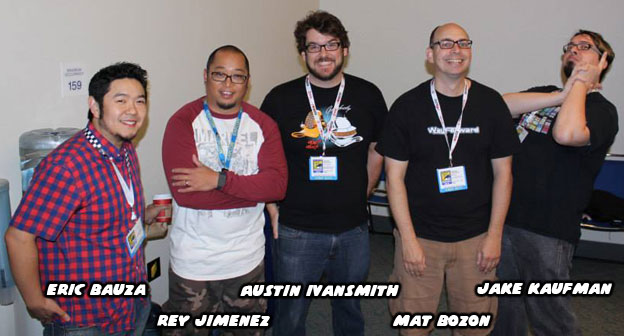
At
the San Diego Comic-Con one of the more anticipated gaming panels
highlighted DuckTales: Remastered
. It turned out to be much more than a
remake. Capcom producer Rey Jimenez introduced his guests Eric Bauza,
the newly-cast voice of Gizmo Duck / Fenton Crackshell. Hamilton Camp,
the original voice actor passed away in 2005. Jake Kaufman worked for
developer Way Forward and was the composer on the remake. Mat Bozon, the
Way Forward Creative Director and Austin Ivansmith the Way Forward
Director and Game Designer. Over the past few years Capcom had found
some success remaking classic 8-bit games for the modern consoles, with
enhanced graphics, levels and controls. Bionic Commando, Dungeons and
Dragons: Shadow over Mystaria, Final Fight and Commando 3: Wolf of the
Battlefield were some of the classic games that got a new lease on life,
and sold hundreds of thousands of downloadable copies for the parent
company. Fans had been asking Capcom to remake DuckTales for over a
decade and the studio wanted to revisit the franchise as well but the
cards never seemed to line up for the publisher. When the studio took
another look at the license they were able to match it up with veteran
developers Way Forward and begin the task of a remake. Jimenez and his
guests agreed that there was tremendous pressure from the fan community
to make the game right. The studios could not cut any corners or they
would be stepping on the memories of an entire generation. The first
thing they did was look at how and why the original game worked. Then
they looked at the game within the context of the DuckTales animated
series as well as the Uncle Scrooge comics that predated it. They grew
to appreciate how influential Carl Barks had been to the show. Both Way
Forward and Capcom wanted to carry over the wonderful characters,
locations and situations that Barks had inspired into the remake.

As
with the original game players could still go through the levels in any
order they chose, however every detail in the game would be built from
scratch. The first thing Way Forward wanted to do was recreate the
proportions of the 8-bit classic while incorporating design elements
from the show. Scrooge for example had a red coat in the comics and in
the game however on the television show he wore blue. Proportionally
Scrooge was also a taller character in the cartoons than in the game.
The studio reworked the pose and head to body ratio so that it did not
look odd to audiences or game players. The reworked look was not done
solely for aesthetic reasons. The way the game controlled or rather
“felt” to players depended greatly on the proportions of the character.
Scrooge had a great centerline. Players could easily track him while
running, jumping and bouncing on the pogo cane. This was important to
when leaping from platform to platform or when trying to drop onto the
head of an opponent. Solid gameplay, rather than nice graphics, could
make or break the title after all. Way Forward wanted to make sure that
even with the redone visuals and levels that the game still played
comparably to the first. They went so far as to create a mock up of the
original levels and run a controller that moved the original sprite on
one screen and the new model on a separate screen and see how they
matched up. They ran at the same pace, jumped and turned at the same
time as well. Despite adding frames of animation and smoothing out the
transitions between moving and standing still the character still
behaved similarly to his 8-bit counterpart.

The
same attention to detail and visual upgrade was applied to all the
other characters and opponents in the game. When redesigning the
hockey-playing minion the studio added pads and taped up his hockey
stick. These were minor but appropriate changes. Then to reinforce the
cartoon theme they curved up the hockey mask to make the villain look
more like the original Mighty Duck mascot as well. In the original game
players also faced bees that seemed out of place. Disney worked with the
studio to help get reference material on actual bee characters that the
studio had created for wartime efforts as well as their employee
appreciation awards. These newly redesigned insects fit the theme of the
cartoon much better.

Way
Forward went back to the basics when creating the animations for the
characters. They took a page from the book of classic cartooning and
filmed themselves performing the actions they wanted to recreate. In one
instance the studio wanted to give Scrooge a new standing still
animation where he twirled his cane while standing at the ready. They
filmed themselves walking like a duck and twirling the cane in their
offices. It may sound absurd but these animator tricks translated very
well to the new game. Way Forward created new frames of animation that
complimented the personality that the artists working on the Disney
Afternoon had created.

Way
Forward and Capcom found that working with Disney was very easy. They
were eager to share assets from the cartoon and comics when asked. They
went the extra step and helped get the developers in touch with people
that worked on the show itself. One such artist was Mike Peraza. He
worked on the original run of the series along with several other Disney
television shows and animated features. He was asked to create entirely
new assets for the game that mirrored the look and feel of the cartoon.
Mike was a perfect choice and one whose announcements were interesting
to follow online. He teased his Facebook friends that he was working on a
new project. The details were mysterious and fans were eager to find
out what sort of project he had been put on. Those that knew of his work
were not disappointed. Mr. Peraza’s art influenced the layout of the
stages and help ensure the accuracy of the tiny details. The placement
of Scrooge’s desk in relationship to the door of the Money Bin and
Downtown Duckburg looked exactly as audiences remembered it. The colors
of the stages looked sampled right out of the cartoon and were much more
vivid than the game originally was in fact. This was more than a
coincidence.
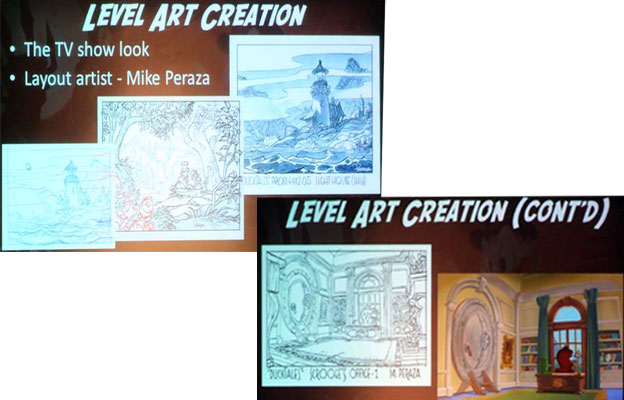
As
Mr. Peraza was painting the concept art for the stages he not only
helped set the tone for the game but was also helping train the Way
Forward artists in Disney tradition. For example, when they were
recreating downtown Duckburg shot from the opening of the television
series he had the artists create the art from back to front. By doing so
the animators were able to create the illusion of depth by scrolling
each layer at a different speed. The details furthest in the background
moved slowly while those in the forefront moved quickly, just as a
perspective shot would work in real life. These things of course could
be traced back to the multilane camera that Disney had pioneered 80
years ago.

In
other stages the artists at Way Forward tried to faithfully adapt the
Peraza concept art into levels. They went so far as to turn his painted
objects into textures that could be wrapped around the 3D computer
objects. The end result were levels that held the illusion of depth but
kept the gameplay on one plane. This design was sometimes called 2.5D
and the stages created for DuckTales had far more personality than
almost any traditionally created background.

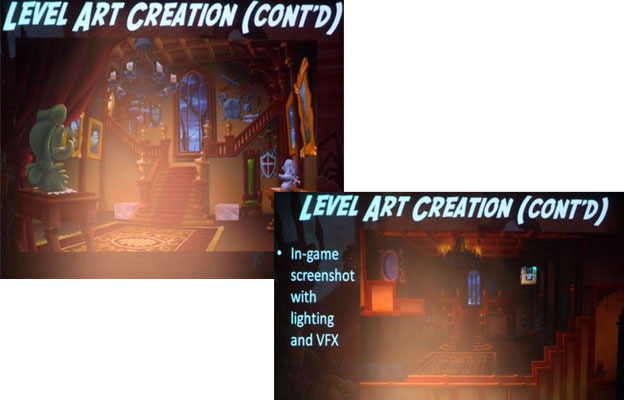
These
levels got the same amount of TLC as the characters and details. Way
Forward did not want to simply recreate the stages verbatim from the old
Nintendo cartridges. They instead used the progression of each stage as
a template to build from. They added in new rooms, puzzles, secrets and
obstacles that were designed to compliment the original designs. In
many ways the levels in DuckTales: Remastered were meant to rekindle the
sense of nostalgia from classic platform titles even though a third or
more of the levels were completely new.

Jake
Kaufman was tasked with redoing the soundtrack, considered to be one of
the best from the 8-bit generation. He noted that he was very much a
fan of the original game and had grown up with it as much as the Comic
Con attendees had. He had studied the work from the Capcom music
producers very carefully and tried to flesh out the compositions to the
best of his abilities. He did not make any radical departures from the
original soundtrack. The melodies explored on the original game have all
returned and been expanded upon. Mr. Kaufman was able to assign
individual instruments and complete arrangements to the limited bleeps
and blips that were featured in the original game. The lack of audio
channels and memory constraints that had limited the Capcom sound and
music programmers meant that they had to be very creative with their
song construction. Jake was able to pick out the stylistic influences
behind each stage theme and turned them into robust versions of the
songs that the audience had grown up with. He mentioned that he felt as
much pressure as the rest of the team did if not more. He knew the
expectations for the game were extremely high and audiences would tear
apart Way Forward and Capcom if they messed with the legacy in any way.

Disney
was able to secure almost all of the original voice actors from the
series and cast for new actors when they couldn’t. Unfortunately for
Capcom and Way Forward this was done well into the development of the
game. This meant that the team did not have enough time to animate the
characters speaking. Instead players see the dialogue boxes and only
hear the tracks that they recorded for the game. The developers had
nothing but great things to say about working with the original cast.
Eric Bauza reinforced the pressure that the team was under to get the
game right. Like the others he had grown up with the show and game and
wanted to do the legacy justice. Getting an opportunity to voice a
character was a dream come true. All agreed however that the biggest
treat was having Alan Young voice Scrooge McDuck once more. Alan joked
that he kept the Scottish accent very thin and if his family overseas
were to hear him they wouldn’t recognize it anymore. He mentioned that
the largest amount of fan mail he got were actually from Mr. Ed fans but
those letters had been few and far between. Capcom producer Rey Jimenez
and Way Forward’s Mat Bozon agreed that something was not right about
that. They said that an entire generation had grown up on DuckTales.
These fans were now parents and raising the next generation of duck
fans. These fans had become artists, animators, designers and composers
thanks in part to the show. Both asked the Comic Con attendees that the
fans of the shows, fans of the comics and games owed it to Mr. Young to
send him a letter or even a post card to say how much his Scrooge McDuck
meant to them and how eager they were to hear him in the new game. We
may not have Mr. Young with us much longer and he should know what a
gift he left the world. This sentiment was met with a roar of applause
from the audience.
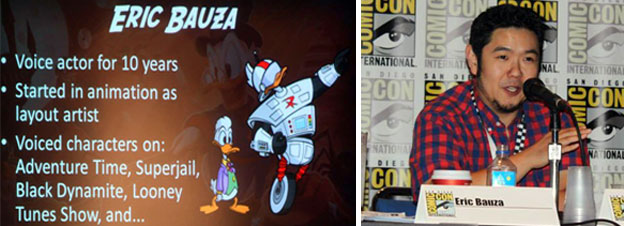
Capcom
and Way Forward convinced audiences that this was the remake that
gamers had been waiting for. The attention to detail and care behind the
development of the game could not be understated. At each industry and
public showing, PAX East, E3 and Comic-Con, there has been progress
made and polish added to the experience. It played as well as the
original game and looks much more wonderful than anyone could have
imagined. In short Capcom gave players and Disney fans the type of
experience that had been lacking for years. They closed out the panel
with a special performance of the Moon Theme from the original game.
Jake mentioned that the actual level music still kept the same upbeat
tempo. He made a second arrangement which was more orchestral and slower
just for the team. However as they would play the recording in their
offices people would gather around and listen intently. Some actually
had tears in their eyes listening to the music. The song was so powerful
that they decided to include it on the credits of the game.
Tad
Stones and Jymn Magon had created most of the Disney Afternoon shows
and had hosted their own panel later that same day. However what they
said would explain the strong reaction that the Way Forward team had
while developing the game. They said that the Disney Afternoon raised an
entire generation of children. These were latchkey kids whose mom and
dad were at work to make ends meet. When they got home they had one
thing they could look forward to and that was DuckTales, that was Gummi
Bears, that was Tale Spin, Goof Troop, Darkwing Duck… and the audience
roared. When kids say they were raised on the Disney Afternoon they mean
it. When Rey, Jake, Eric and Mat said that they got emotional while
working on the title they each meant it. They had grown up watching the
cartoons and playing the games. They would get to work with the same
artists and voice actors that they idolized as children. It was a
bittersweet ending to a legacy that Disney never seemed to acknowledge
until the kids were able to call the shots. When they were able to
revisit the era that they considered great there was no denying that
they would get very emotional.
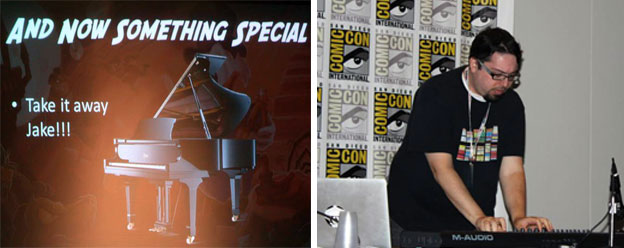
DuckTales
Remastered is scheduled to be a downloadable title for the PC, Wii U,
Xbox 360 and Playstation 3 on August 13. For collectors a physical box
will only be made available for the PS3, however that will not include a
disk but instead a download code. No confirmation has been made on a
soundtrack available for download as well.
Fan Letters for Mr. Young can go to:
Alan Young c/o TGMD Talent Agency
6767 Forest Lawn Drive
Suite 101
Los Angeles, CA 90068
USA
Video Games & Technology
“Adventure Time: Pirates of the Enchiridion” game coming this summer
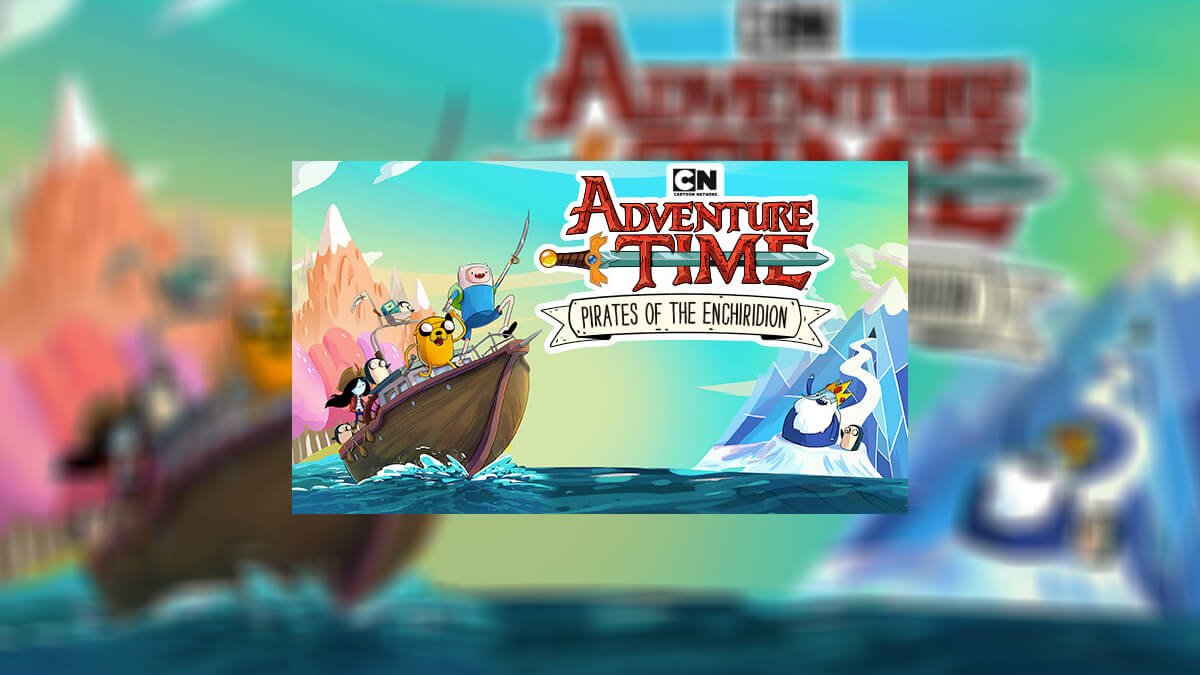
“C’mon on, grab your friends … ” A new Adventure Time game is coming out across multiple platforms.
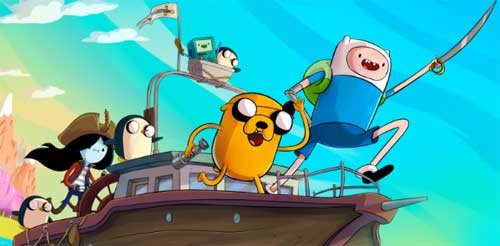 Copyright Cartoon Network / Outright Games Ltd. All rights reserved
Copyright Cartoon Network / Outright Games Ltd. All rights reserved
In this open world game, Finn and Jake will be sailing on a raft (Named Jeff) through the flooded land of Ooo to solve the mystery of why water engulfed their home and to help others & get in hijinks along the way. With a ragtag gang of friends (From a vampire, to an Ice King, to a little robot) Finn and Jake will travel from the melting Ice Kingdom to the Fire Kingdom and fight in turn-based combat like an RPG.
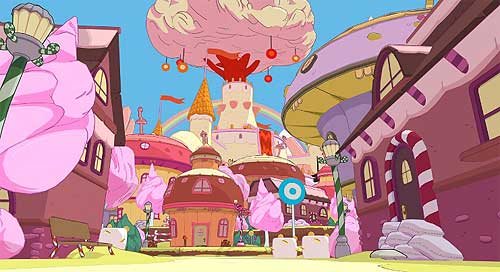 Copyright Cartoon Network / Outright Games Ltd. All rights reserved
Copyright Cartoon Network / Outright Games Ltd. All rights reserved
The trailer shows off some absolutely gorgeous character models and environments. I’m particularly enchanted by the gorgeous Candy Kingdom that’s briefly shown in this footage. The art design sticks close to the show, but brings with it a soft, sweet design rarely seen in adventure games. Which is a refreshing thing to bring to the table. Likewise, it’s a joy to see the characters translate to 3D so well. Outright Games has done some fantastic work here with their art design.
 Copyright Cartoon Network / Outright Games Ltd. All rights reserved
Copyright Cartoon Network / Outright Games Ltd. All rights reserved
Likewise, the voice cast for the show will be reprising their roles as characters in the land of Ooo. And they’ll have a lot of lines to record. Not only can you control Finn and Jake, but you’ll be able to play as BMO and Marceline as well. You can upgrade these characters to unlock unique abilities for combat and the map holds plenty of fun mysteries too. With side stories and secret locations, this seems like a game that’ll have hours & hours of fun.
 Copyright Cartoon Network / Outright Games Ltd. All rights reserved
Copyright Cartoon Network / Outright Games Ltd. All rights reserved
What strikes me particularly about this game is how much it resembles Legend of Zelda: Wind Waker. This is no coincidence. Adventure Time have a history of being direct corollaries to Legend of Zelda games. “Adventure Time: Hey Ice King! Why’d You Steal Our Garbage?!” ‘s gameplay references “Zelda II: The Adventure of Link” and “Adventure Time: The Secret of the Nameless Kingdom” has the same top down look & combat stylings as “Legend of Zelda: A Link to the Past.” With this in mind, it’s absolutely delightful to see a Wind Waker homage with a series like this. Wind Waker was a gamechanger for the Legend of Zelda series, and it feels like “Pirates of the Enchiridion” will be a gamechanger for the Adventure Time games.
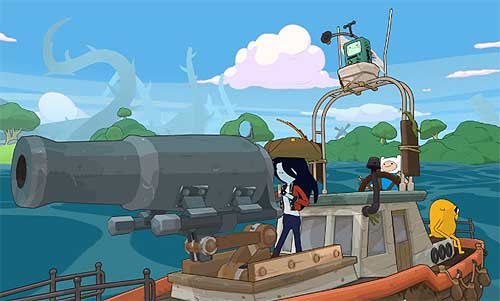 Copyright Cartoon Network / Outright Games Ltd. All rights reserved
Copyright Cartoon Network / Outright Games Ltd. All rights reserved
‘Adventure Time: Pirates of the Enchiridion’ will be out July 17th for the Nintendo Switch, Xbox One, Playstation 4, and PC.
Video Games & Technology
Do you like treasure hunting and/or cooking soup? Then Pokemon Quest is the game for you
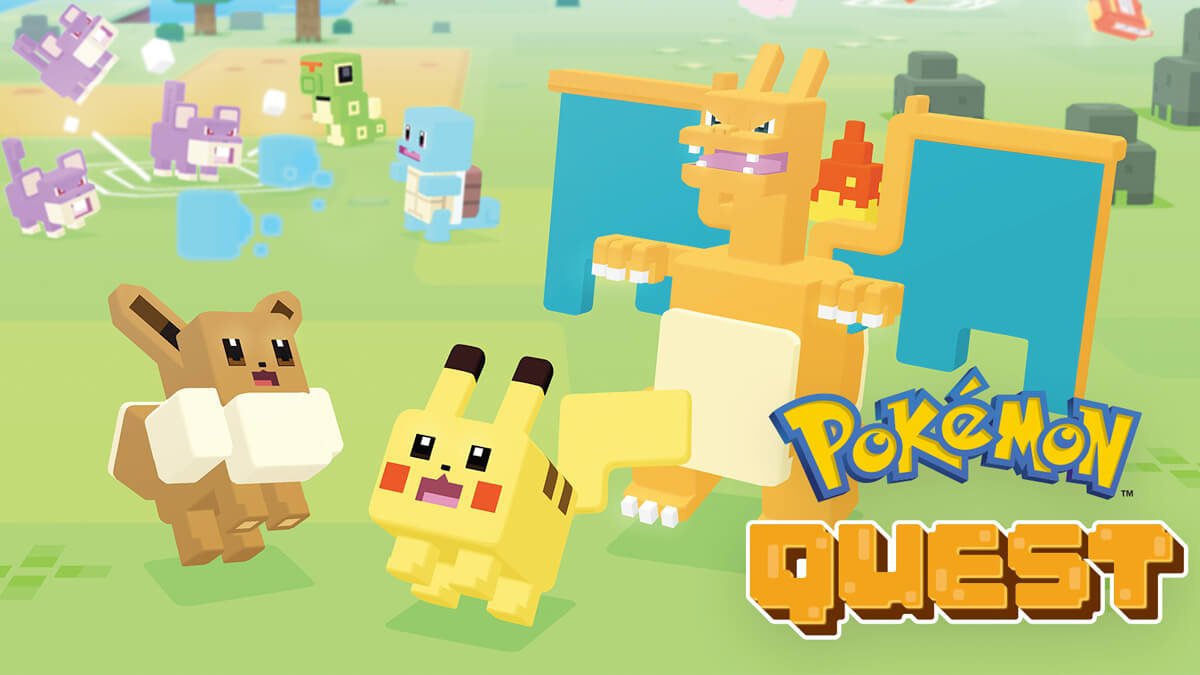
Immediately after the Pokemon press conference on May 29th, the mobile-switch cross platform game Pokemon Quest was available to download on the Nintendo eShop (with the mobile device version debuting later this month). Curious about the ‘Free-to-Start’ game, I snagged a download and started playing.
 Copyright 2018 Nintendo. All rights reserved
Copyright 2018 Nintendo. All rights reserved
Pokemon Quest is a game that feels best letting itself auto-run. You check in several times a day to see what Pokemon have appeared at your camp (The conceit behind this game is that you’re a treasure hunter & Pokemon flock to you to fight their brethren in your honor. They also sometimes just come by because you make really good soup. What can I say?). With the Pokemon at your disposal, you build a small exploration team much in the same style as the Pokemon Mystery Dungeon game series. And you then set them out to fight other Pokemon in open levels. From these battles, you win power stones (which allow you to upgrade your Pokemon’s health & attack power), and ingredients to lure other Pokemon to your camp.
You may’ve taken notice use of the term ‘Free-to-Start’ earlier in this article. That’s because — like many mobile services — this game offers add-ons for purchase. I don’t see any age limit on the Nintendo Switch version to take away ads for purchases (which many mobile games have chosen to add. See Disney’s own ‘Disney Crossy Road’) but the Pokemon Company may be expecting parents to set their own controls over the switch with the parental controls available on the system.
 Copyright 2018 Nintendo. All rights reserved
Copyright 2018 Nintendo. All rights reserved
Still, the game is typical in mobile game fare for trying to wring money out of players. Energy to play the game costs P tickets, which you can earn 50 a day … or you can just buy. The game gives you an amount to start with, shows you how to use them to speed up your game, and then takes you to the shop where you can see an advertisement to buy it — along with Pokemon furniture to help your team.
These packages can go up to $30 and include Pokemon in-game items & exclusive furniture. And while Pokemon Go offered items in bundles like this, it’s still odd to see in a Pokemon game — let alone a Pokemon game on the Nintendo Switch (albeit, this is a cross-platform game). The game itself doesn’t seem to have any sort of hard-pay line for gameplay, though. I’m up to the fifth world in my game without making any purchases. And while the game difficulty has dramatically ramped up, likely to encourage purchases, it’s still completely manageable to play without paying.
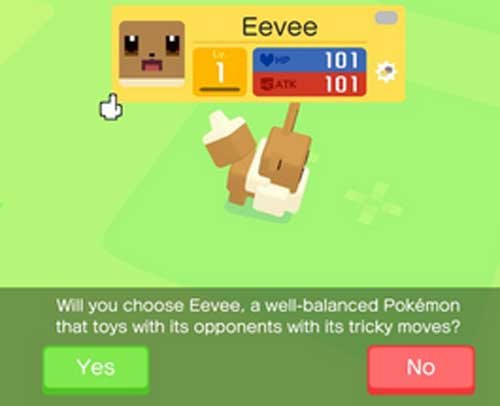 Copyright 2018 Nintendo. All rights reserved
Copyright 2018 Nintendo. All rights reserved
In that sense, for a free game, it’s really cute & enjoyable. The graphics are pleasing and colorful. And if you return to camp, you’ll find all the Pokemon you’ve befriended hopping around adorable decorations. Sometimes stacking on top of each other, other times following each other around in what seems like games of tag.
The ‘cooking’ mechanic to encounter a random Pokemon makes encountering them feel less like gambling and more like strategy. By cooking certain recipes from materials you find on missions, you can draw certain types of Pokemon to your camp. Cooking in certain pots (unlocked by playing through the game) can draw higher powered Pokemon at the cost of more materials. And waiting while your energy fills up means running out of ingredients (At the point of the game I’m at, about half-way through) doesn’t seem to be a problem.
 Copyright 2018 Nintendo. All rights reserved
Copyright 2018 Nintendo. All rights reserved
All in all, I’d say, if you have access to this game, check it out and see if it’s for you. There doesn’t seem to be cross platform support for other Pokemon games. But as a standalone, it’s a cute, fun blip of a game. The hard ‘end’ of the levels within surprises me, especially since it seems to end with 150 Pokemon (out of the over eight hundred available). So I’m not sure what there is to get out of it when you get to the end level outside of getting every Pokemon. But it’s still a fun, very casual strategy game. Just keep an eye on purchases if your children decide to play.
Video Games & Technology
“Pokemon — Let’s Go, Pikachu !” & “Pokemon — Let’s Go, Eevee !” to come to the Nintendo Switch this year

During a conference in Japan earlier this week, the Pokemon Company revealed three new games : A mobile and Nintendo Switch cross platform game, “Pokemon Quest,” with graphics similar to Crossy Road and some absolutely adorable furniture in a “free to start” format; and for the Nintendo Switch, “Pokemon — Let’s Go, Pikachu !” and “Pokemon — Let’s Go, Eevee !”
Taking inspiration from gameplay styles from the popular “Pokemon Go” for mobile devices, “Pokemon — Let’s Go, Pikachu !” and “Pokemon — Let’s Go, Eevee !’ adopts the thrown Pokeball system. By using one controller with the Switch system, you can make a tossing motion to throw a Pokeball and capture a cute critter for your team.
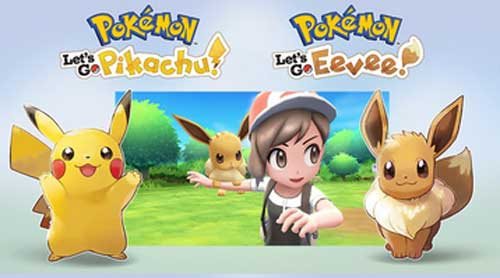
Additionally, you can buy the “Pokeball Plus” accessory to act as an additional “Joy-con” controller for your Switch to capture Pokemon. Then load a Pokemon into your pokeball, and take it out on the go.
From there, with the accessory, you’ll be able to interact with the Pokemon you have inside. Although current information doesn’t offer whether we’ll have more options than putting Eevee or Pikachu in the Pokeball Plus, the footage seen in the linked trailer is absolutely adorable.
The game itself seems to be a remake of Pokemon Yellow, a game released twenty years ago for the Game Boy Color. You explore the Kanto Pokemon region, and seem to be limited to the 150 Pokemon available when that game was out (Well, 151, if you were lucky, or good at exploiting glitches). But these games ditch the random encounters of mainline Pokemon games and adopt the overworld encounters of Pokemon Go. What Pokemon you see on the overworld is what you get.

Additionally, Pokemon can follow you around and you can ride some of them. In footage, we see a trainer riding a giant Onyx (i.e., a giant snake made out of rocks. Who wouldn’t be comfortable riding on that?) and followed by a starting Pokemon, Bulbasaur. Although in these two games, you start instead with the series mascot Pikachu, and the evolution Pokemon Eevee, which can evolve into several different pokemon. You can also put little outfits on them. Which is – frankly — incredible.
Likewise, this seems to have local multiplayer. Hand the left Joy-con to a friend and let them enter your game. Or if you’re feeling really lonely, put the left Joy-con in your hand and pretend you have a friend while controlling the new trainer that arrives. What a fun time!
You and your friend can then team up to capture Pokemon together, or go exploring together- And you can have Pokemon you capture in Pokemon Go (of the original 151 Pokemon) arrive in your game. You can also send “Presents” back to your Pokemon Go game, including a possible new form of Pokemon as the trailer discusses.
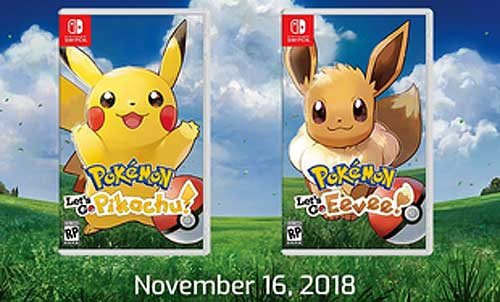
“Pokemon — Let’s Go, Pikachu !” and “Pokemon — Let’s Go, Eevee !” will be arriving on the Nintendo Switch this November. Likewise, a new Pokemon game will be released in the second Half of 2019. With a Mario movie in development and theme park additions on the way, it’s sure to be a busy year for Nintendo.
-

 Film & Movies7 months ago
Film & Movies7 months agoBefore He Was 626: The Surprisingly Dark Origins of Disney’s Stitch
-

 History5 months ago
History5 months agoCalifornia Misadventure
-

 History10 months ago
History10 months agoThe Super Bowl & Disney: The Untold Story Behind ‘I’m Going to Disneyland!’
-

 Television & Shows11 months ago
Television & Shows11 months agoHow the Creators of South Park Tricked A-List Celebrities to Roast Universal – “Your Studio & You”
-

 Film & Movies7 months ago
Film & Movies7 months agoThe Best Disney Animation Film Never Made – “Chanticleer”
-

 Theme Parks & Themed Entertainment6 months ago
Theme Parks & Themed Entertainment6 months agoThe ExtraTERRORestrial Files
-

 History7 months ago
History7 months agoWhy Disney’s Animal Kingdom’s Beastly Kingdom Was Never Built
-

 Television & Shows8 months ago
Television & Shows8 months agoThe Untold Story of Super Soap Weekend at Disney-MGM Studios: How Daytime TV Took Over the Parks






